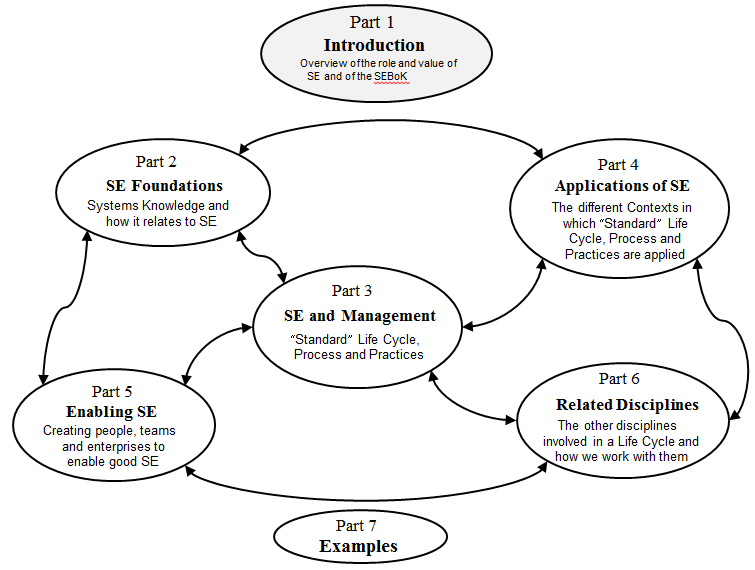Difference between revisions of "Introduction to the SEBoK"
m Tag: visualeditor |
(Tech and grammar edits as discussed with Bkcase) |
||
| Line 1: | Line 1: | ||
| − | The SEBoK | + | The purpose of the ''Guide to the Systems Engineering Body of Knowledge (SEBoK)'' is to provide a widely accepted, community-based, and regularly updated baseline of {{Term|Systems Engineering (glossary)}} (SE) knowledge. SEBoK Part 1 contains an introduction to both the discipline of SE, and an introduction to and guide for the use of the SEBoK wiki. |
| + | [[File:SEBoK Navigation Introduction.PNG|centre|thumb|755x755px|'''Figure 1. SEBoK Part 1 in context (SEBoK Original).''' For more detail see [[Structure of the SEBoK]]]] | ||
| + | Part 1 also includes an introduction to some of the emerging aspects of systems engineering and a discussion of how these are transforming the discipline. As this knowledge matures, it will be migrated into the main body of the SEBoK. | ||
| − | == | + | ==Part 1 Knowledge Areas== |
| − | Each part of the SEBoK is divided into | + | Each part of the SEBoK is divided into knowledge areas (KAs), which are groupings of information with a related theme. Part 1 contains the following KAs: |
| − | *[[ | + | *[[Introduction to the SEBoK]] |
| − | *[[ | + | *[[Introduction to Systems Engineering]] |
| + | *[[Introduction to SE Transformation]] | ||
| + | *Digital Engineering | ||
| + | *Set Based Design | ||
| + | *[[SEBoK Users and Uses]] | ||
| + | ==Scope and Context of the SEBoK== | ||
| + | While Part 1 introduces Systems Engineering knowledge areas, the remaining SEBoK content (Parts 2 – 6) focuses on domain-independent information—that which is universal to systems engineering regardless of the domain in which it is applied. Part 7 includes examples from real projects. These illustrate the concepts discussed elsewhere in the SEBoK, while detailing considerations relevant to domains such as aerospace, medicine, and transportation. | ||
| + | |||
| + | SE in the context of engineered systems (ES) is the primary scope for the SEBoK, though general systems concepts are also discussed in Part 2. The SEBoK also covers considerations for the disciplines of software engineering and project management, which are strongly intertwined with the practice of SE (see [[Related Disciplines|Part 6]]). | ||
==References== | ==References== | ||
| − | ===Works Cited=== | + | === Works Cited === |
| − | None | + | None |
| − | |||
| − | |||
| − | |||
| − | |||
| − | |||
| − | |||
| − | |||
| − | |||
| − | |||
| + | === Primary References === | ||
| + | None | ||
---- | ---- | ||
| − | <center>[[SEBoK | + | <center>[[SEBoK Table of Contents|< Return to Table of Contents]] | [[SEBoK Table of Contents|Parent Article]] | [[Introduction to the SEBoK|Next Article >]]</center> |
| + | [[Category:Part]] | ||
| + | [[Category:Part 1]] | ||
<center>'''SEBoK v. 2.1, released 31 October 2019'''</center> | <center>'''SEBoK v. 2.1, released 31 October 2019'''</center> | ||
| − | |||
| − | |||
| − | |||
Revision as of 02:48, 14 March 2020
The purpose of the Guide to the Systems Engineering Body of Knowledge (SEBoK) is to provide a widely accepted, community-based, and regularly updated baseline of systems engineering (SE) knowledge. SEBoK Part 1 contains an introduction to both the discipline of SE, and an introduction to and guide for the use of the SEBoK wiki.

Part 1 also includes an introduction to some of the emerging aspects of systems engineering and a discussion of how these are transforming the discipline. As this knowledge matures, it will be migrated into the main body of the SEBoK.
Part 1 Knowledge Areas
Each part of the SEBoK is divided into knowledge areas (KAs), which are groupings of information with a related theme. Part 1 contains the following KAs:
- Introduction to the SEBoK
- Introduction to Systems Engineering
- Introduction to SE Transformation
- Digital Engineering
- Set Based Design
- SEBoK Users and Uses
Scope and Context of the SEBoK
While Part 1 introduces Systems Engineering knowledge areas, the remaining SEBoK content (Parts 2 – 6) focuses on domain-independent information—that which is universal to systems engineering regardless of the domain in which it is applied. Part 7 includes examples from real projects. These illustrate the concepts discussed elsewhere in the SEBoK, while detailing considerations relevant to domains such as aerospace, medicine, and transportation.
SE in the context of engineered systems (ES) is the primary scope for the SEBoK, though general systems concepts are also discussed in Part 2. The SEBoK also covers considerations for the disciplines of software engineering and project management, which are strongly intertwined with the practice of SE (see Part 6).
References
Works Cited
None
Primary References
None